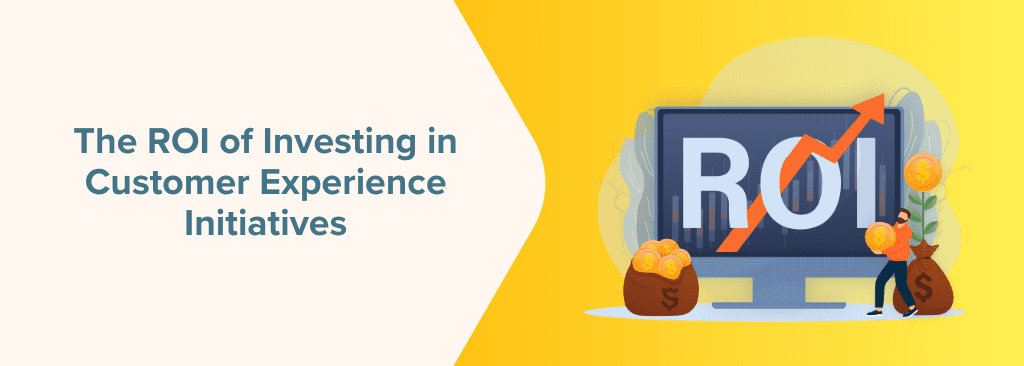Show Me the Money: The ROI of Investing in Customer Experience Initiatives
Customer Experience (CX) function does not find a seat at the table in the boardroom of most organizations. Customer Experience is an afterthought in comparison to other priorities.
I will talk about a few findings and how contradictory organizations behave when it comes to CX.
#1 According to a study by Forrester, companies with a strong focus on CX outperform their peers in terms of revenue growth.
However, organizations prioritize immediate financial gains over long-term customer satisfaction.
#2 A Qualtrics study says that only 29% of companies regularly use customer feedback to inform business decisions.
Most executives in a boardroom may question the ROI of CX initiatives without concrete metrics.
#3 Harvard Business Review survey states that 58% of companies struggle with internal silos that hinder collaboration for better customer experiences.
Most organizations have a disconnect between marketing, sales, and customer service strategies.
#4 According to Bain & Company, 80% of companies believe they deliver superior customer service, but only 8% of customers agree.
Companies are overly fixated on their products and features and easily overlook the importance of customer-centric strategies.
#5 According to McKinsey, a 10% improvement in a company’s customer experience score can increase customer loyalty by 12-15%.
However, most organizations do not fully grasp how CX positively impacts customer loyalty and brand reputation.
#6 Companies with a Chief Customer Officer (CCO) are more likely to be customer experience leaders, according to Customer Gauge.
Most organizations do not have executives advocating customer-centric practices at the top level.
This means that if CX has to find a seat in the boardroom, it has to make financial sense. The only language that the executives in the boardroom understand is the return on investment.
What is the ROI or the financial impact of CX initiatives? If we can measure them, it would resonate well in the boardroom.
How Do You Measure the Financial Impact of CX Initiatives?
Here are some metrics that would help you understand and measure the financial impact of CX initiatives.
1. Customer Lifetime Value (CLV)
Measure the total revenue a business expects from a customer throughout their relationship.
A positive impact on Customer Lifetime Value (CLV) suggests customer experience initiatives foster loyalty and repeat business.
2. Net Promoter Score (NPS)
Evaluate customer satisfaction and loyalty by calculating the NPS based on customer feedback. Higher NPS scores often correlate with increased customer retention and referrals, leading to positive financial outcomes. However, this might be a complex metric to measure as most customers may prefer not to give feedback.
3. Customer Churn Rate
Monitor the percentage of customers who stop using a product or service. A lower customer churn rate indicates that customer experience initiatives effectively retain customers, which is financially beneficial in the long run.
4. Customer Satisfaction (CSAT) Scores
Gauge customer satisfaction through CSAT surveys. Higher satisfaction scores generally correlate with increased customer loyalty and positive financial impact.
5. Customer Acquisition Cost (CAC)
Analyze the cost of acquiring new customers. If customer experience initiatives contribute to lower acquisition costs, it implies that existing customers are more likely to refer new business, reducing the need for expensive marketing efforts.
6. Upsell and Cross-sell Metrics
Examine the success of upselling or cross-selling efforts driven by customer experience initiatives. Improved cross-selling and upselling indicate that customers are receptive to additional offerings, contributing to increased revenue.
7. Customer Effort Score (CES)
Assess the ease with which customers can resolve issues or complete tasks. Lower customer effort scores are associated with increased loyalty and decreased operational costs, positively impacting the bottom line.
8. Average Transaction Value (ATV)
Evaluate changes in the average value of customer transactions. Satisfied customers may be more willing to make larger purchases or add additional products and services.
9. Social Media and Online Reviews
Monitor social media and online review platforms for customer feedback. Positive sentiment and favorable reviews can contribute to a positive brand image, attracting new customers and influencing purchasing decisions.
It is often beneficial to use a combination of these metrics to get a comprehensive understanding of the financial impact of customer experience initiatives.
Measuring the financial impact of customer experience initiatives is essential for businesses aiming to thrive in today’s competitive landscape.
The true success stories often emerge as anecdotes that illustrate the tangible benefits experienced by both customers and the business.
Take, for instance, the tale of a telecommunications company that revamped its customer service protocols. By prioritizing quick issue resolution and personalized interactions, they witnessed a significant decrease in customer churn and an uptick in positive online reviews.
This shift not only improved customer satisfaction but also translated into a noticeable boost in customer retention, positively impacting the company’s bottom line.
Similarly, a local retail business invested in enhancing the in-store experience. Through attentive staff training and a commitment to creating a welcoming environment, they saw an increase in the average transaction value and a surge in word-of-mouth referrals. Customers became brand advocates, sharing their positive experiences with friends and family, ultimately driving new business without the need for substantial marketing investments.
These anecdotes underscore the qualitative impact of customer experience initiatives, demonstrating that beyond the metrics, there are real, tangible benefits that contribute to the financial success of a business.
